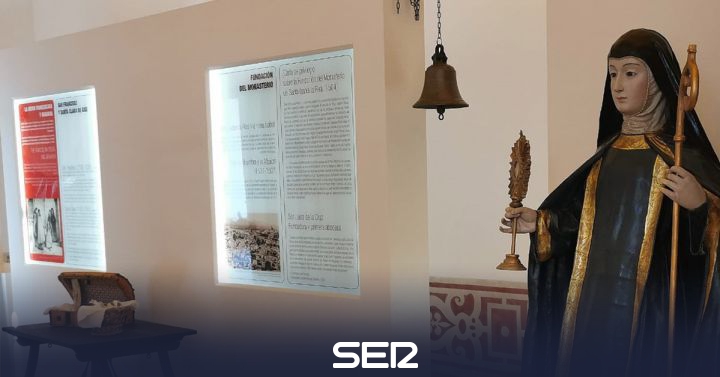The Montemadrid Foundation and the community of Poor Clares of the Santa Isabel la Real monastery, in the heart of Granada’s Albaicín, have The exhibition “Santa Isabel la Real: 500 years of life in a monastery” was inaugurated on the premises.
It is a permanent exhibition with which the restoration started in 2008 culminates by the Montemadrid Foundation and the nuns, to recover one of Granada’s hidden gems.
The restoration, whose budget amounted to the amount of 1,185,910 euros, of which the Montemadrid Foundation contributed 948,728 euros and the community of Poor Clare Sisters the remaining 237,182 euros, has been carried out in phases. This amount includes the last phase of the project that was presented this Tuesday, which consisted of the restoration of the old chapter house and in the production of the exhibition that this space houses as a factory hall of the monastery.
The work undertaken throughout these 13 years was carried out on the altarpiece, the wall paintings and the coffered ceiling of the church, as well as on the entrance compass, at the entrance gate to the convent, at the Puerta Reglar and in other smaller spaces, works carried out under the direction of the Granada-born architect Carlos Sánchez, one of the best monument-conserving architects in Spain, and the Montemadrid Foundation.
Among other findings, the restoration process led to the rediscovery, of great interest, both from the historical and artistic point of view, of the set of paintings underlying the Puerta Reglar.
The Monastery of Santa Isabel la Real is one of the most important monuments of Granada’s Albaicín and one of the few monasteries that have been continuously inhabited for so long by the same religious order, overcoming all the confiscation processes of the XIX and the economic difficulties and the crisis of vocations of the XX.
In this link you can manage the visit to the monastery.
The exhibition, which is permanent and is part of the visit to the convent, travels through various museum resources the historical evolution of the monastery and its conservation.
The exhibition is installed in the old chapter house, which had to be restored after being abandoned to other less noble uses, such as the barn, from the 18th century on. In addition, a set of movable property belonging to the monastery has been restored, which can now be viewed in optimal conditions. The installation includes two didactic models, a scale reproduction of the magnificent coffered ceilings of the main staircase and the presbytery, made by the architect and academic Enrique Nuere, considered the most important specialist in Europe in loop carpentry. Along with these, you can see a virtual recreation of the monastery and its old garden.
The exhibition It also tells of the day-to-day life of the community of Poor Clares related by themselves: “Still at night, silence envelops everything and at the touch of the bell our hearts are ready to seek the face of the Beloved: the day begins” or “We continue our work and fit into the week the Theology, music, training or classes. community meeting. Hours go by fast! “, are some of the testimonies that can be read.
Along with the exhibition, The Renaissance fountain in the cloister has been presented, restored throughout this year by the American organization World Monuments Fund, entity of American origin that has contributed the amount of 45,000 euros. This restoration intervention has included the recovery of the hydraulic system of the fountain, so that it can continue to fulfill the primary function that these elements had in the monastic cloisters.
During the presentation ceremony, José Guirao, general director of the Montemadrid Foundation and former Minister of Culture and Sports, recalled that Montemadrid has been restoring monuments throughout Spain since before 2000 and he pointed out that this “is a monument little known by the people of Granada and by tourists, especially on the inside.” He also explained that the objective of this project is to “recover heritage, put in value first-level heritage and, from now on, try to spread it so that the more people know it and enjoy it better. They will learn things, they will enjoy an extraordinary heritage in an extraordinary city “.
He also stressed that the Montemadrid Foundation, whose main source of income is the Montes de Piedad, acquired the Monte de Piedad de Granada five years ago to give pledge credit to Granada society and that “this investment here means giving back to the city of Granada part of what the city of Granada has given to the Foundation, which is dedicated to social and cultural purposes.”
Santa Isabel la Real was one of the first monasteries founded in Granada by Queen Isabel la Católica, twelve years after the conquest of the city. Located in the Albaicín, declared a World Heritage Site, it is one of the great jewels of Granada, sometimes something hidden from the visitor behind the brightness of the Alhambra. The present exhibition and the effort made in restoring the complex are intended to contribute to its greater knowledge and enjoyment. This monastery, whose beauty captured the interest and commitment of the Montemadrid Foundation or the World Monuments Fund, is still inhabited today by the same Poor Clare nuns who founded it.
–

